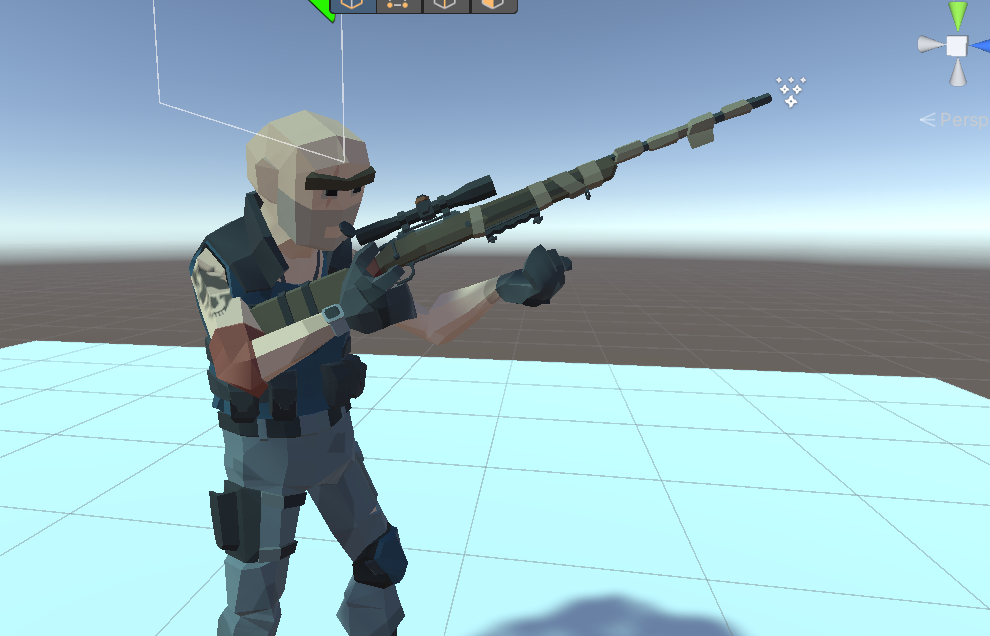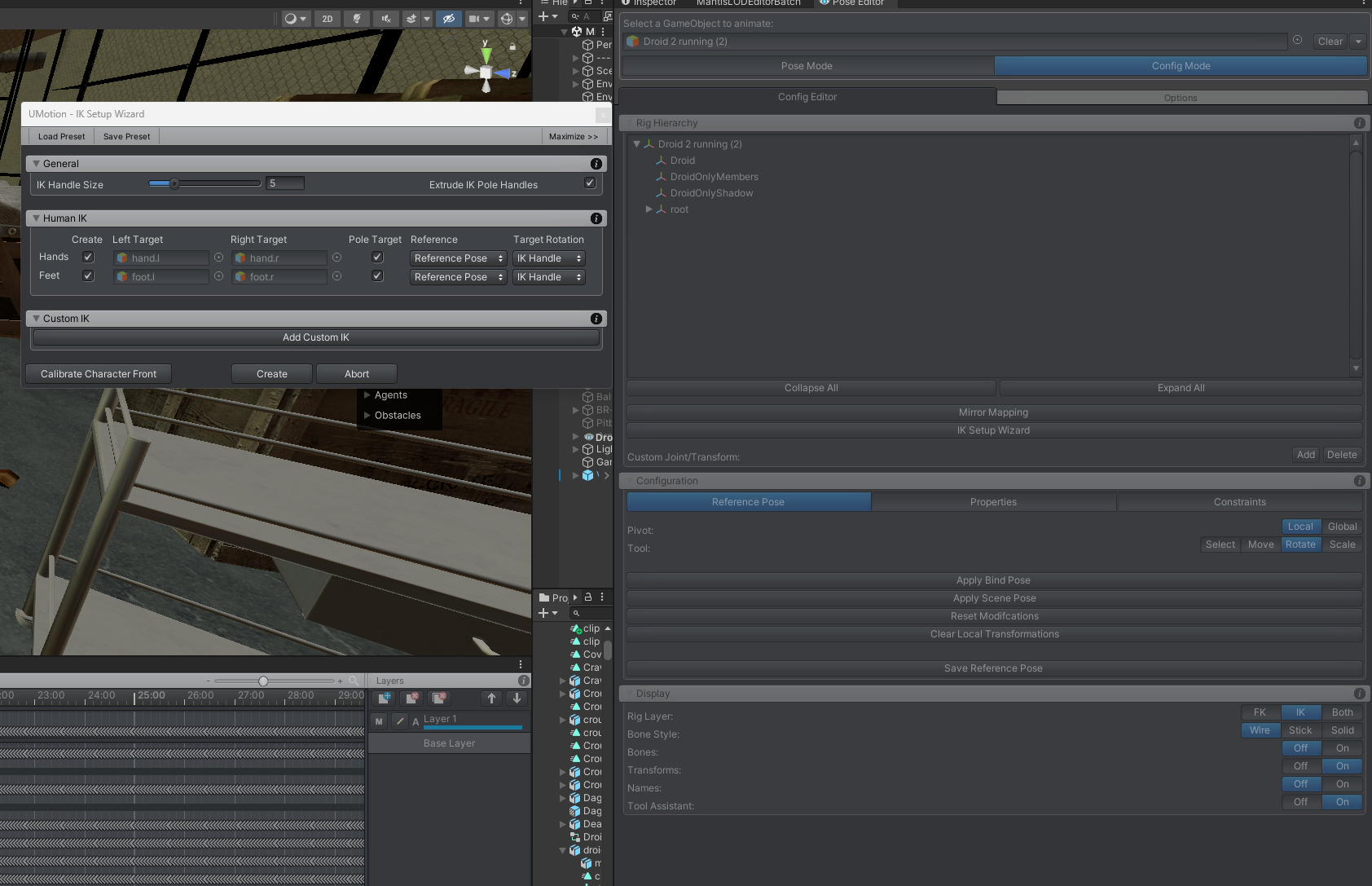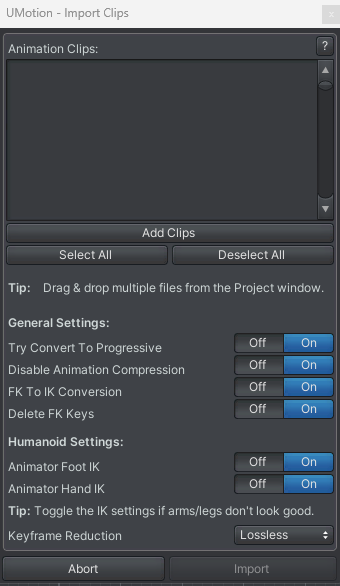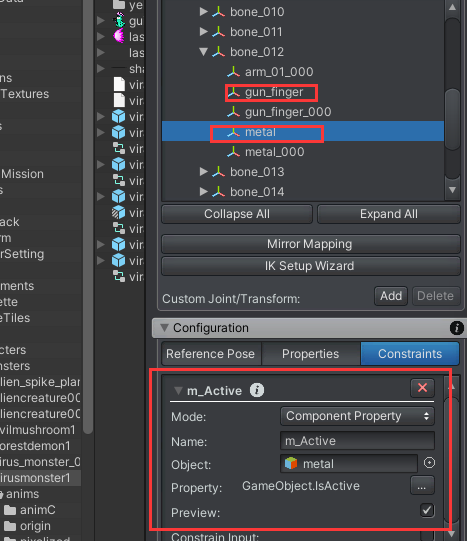
 How to add a item such like weapon
How to add a item such like weapon
How to add a item such like weapon in character hands when i animate my character,and i can edit both character and items transform?


Hi XZ G,
thank you very much for your support request.
If your UMotion project is of type humanoid, be aware that UMotion hides all none humanoid bones by default.
In your humanoid UMotion project, witch into Config Mode and select the additional bone(s). Under the "Properties" tab, set "Visibility" to "Show". This is going to show and include the bone(s) in your animations.
Please let me know in case you have any follow-up questions.
Best regards,
Peter

 Moving a character that is not vertically oriented straight up.
Moving a character that is not vertically oriented straight up.
While I am just familiar enough with the Move and Rotation tools to achieve successful edits, I’m still new to animation in general, so I may be about to ask about a tool or technique that doesn’t exist. My apologies if that is the case. I’m looking for a way to move a character straight up from the floor of a scene within a range of frames within a clip, that does not involve moving all three of the position axis by hand. Even though the Move tool has a center grab point that I can use, it also lets me accidentally move the character off to the side as I attempt to move it straight up.
Because the clip I am editing moves the character in an exercise routine, all of the position axis are constantly changing. Other than adjusting all three axis for every frame I need to adjust, is there a variable, or a control that moves a character strictly vertically other than dragging the character up with the center of the move tool and in all likelihood, having to go back and forth until I get it just right?
Thanks for your time.

Hi David,
thank you very much for your support request.
You can click and drag on one of the arrows of the move tool to limit your adjustment to that specific axis. By switching between "local" and "global" mode you can define if the move tool is oriented along the world space coordinate system (i.e. up points always straight up) or along the object's local coordinate system (i.e. dependent on the objects current orientation).

Please let me know in case you have any follow-up questions.
Best regards,
Peter

 Umotion instantly crashes my unity project
Umotion instantly crashes my unity project
I bought Umotion some days ago, and it worked really well, i made some animations for my project, but today when i tryied to open my unity project and tryied to close Umotion project unity crashed, everytime when i try to interact with Umotion it crashes. I thought maybe reason in my Umotion project and decieded to delete it. After that unity started to crash instanly when open project, and the only way to fix this

to delete Umotion folder from the project. I really like this asset and i hope it wont take to much time to fix this

Hi,
thanks for your support request. I've looked into your editor log. According to the log, native code (i.e. C++ code) in your project crashed. UMotion only uses C++ code when you are actively exporting to FBX, everything else in UMotion is written in C#. Regular C# code can not directly crash Unity. The log doesn't provide any more information on what exactly happened, but from the log it appears that UMotion is only indirectly involved. The crash itself does not seem to happen in any of UMotion's code. Do you have any other plugins in your project that are written in C++?
Best regards,
Peter

Hi,
thanks for reaching out. No, this asset is not abandoned.
But please be aware that support times are currently higher than usual due to limited time schedule due to another project which is in the finishing lines.
Best regards,
Peter

 Foot moves on exported animation
Foot moves on exported animation
I set Foot IK Pinned in the UMotion editor and the foot is fixed as expected.
However, in the exported animation, the feet move.

Hi,
thank you very much for your support request. Foot sliding is a common artifact of the Unity humanoid animation system. Enabling the corrective Foot IK pass of the humanoid animation system in Unity (this can only be done via scripting) can counter this problem. More information on the inner workings of humanoid and also touching foot sliding: https://unity.com/de/blog/engine-platform/mecanim-humanoids
Please let me know in case you have any follow-up questions.
Best regards,
Peter

 Trying to make a demon throw a Fireball
Trying to make a demon throw a Fireball
So I'm trying to make a demon throw a fireball. I have the animation for the body done and now I'm trying to get the Fireball in her hand to be thrown. I tried Parenting it to her hand but it still follows her hand. How would I do this animation?

Dear Drew,
thank you very much for your support request.
One possible approach would be to animate the throwing animation without any fireball in the hand. Then create and parent the fireball via script. You can use animation events to trigger the creation and throwing/releasing of the fire.
Please let me know in case you have any follow-up questions.
Best regards,
Peter
 Unable to hide curves in Unity 6
Unable to hide curves in Unity 6
Hello,
I'm unable to hide a curve by clicking the eye icon in the clip editor. Nothing happens when I left click on the eye. The same is true for the cog in the header. I'm able to right click, just not left click.


Quick update: We've finally been able to find a workaround for this issue that could be implemented in UMotion. The fix is included in the latest UMotion update V1.29p04. The update is currently pending asset store review and should be available in the next few days.
Thanks for your patience and sorry for the long waiting time.
Best regards,
Peter

 IK Poles freaking out
IK Poles freaking out
so I have this issue with umotion pro. I have this animation that plays perfectly fine outside of Umotion but when I import the clip to Umotion and convert it to IK the IK poles go crazy as in weird rotations and positions,
sometimes rapidly, sometimes slowly
this happens 90% of the time with any animations I import, custom, or from Mixamo.
please help
in this case at the moment its the legs
(this is more of a calm situation sometimes it's like 100 miles per hour all over the place flickering)
20241029-1436-08.4766355.mp4
but the original animation when not imported into Umotion does not have this issue
my default setup



Dear angeloT813,
thank you very much for your support request. The conversion to IK isn't always possible without some manual cleanup afterwards. The algorithm has to do some guessing work and if those guesses don't work out you can get weird results.
I recommend fixing the poles at those frames where the calculated pole positions are incorrect (or just delete the key frames of the poles at those frames). Using the curves view of the IK poles position should make this rather simple to spot / fix.
Sorry for the inconvenience.
Best regards,
Peter

 stuttering selection icon
stuttering selection icon
When I press the Q button on my keyboard, the windows selector icon starts stuttering. Is there a way to get this to stop?

Hi,
thank you very much for your support request. Could you show me a video of what you mean by that?
Best regards,
Peter
 Importing existing animations with the “attribute ”encountered an issue
Importing existing animations with the “attribute ”encountered an issue

I have an animation where a certain bone node has two children, and the animation calls the GameObject's active property to show or hide them. After importing this animation, I received a warning indicating that the m_Active attribute does not exist. I tried adding the m_Active field in the custom properties, and one of the error messages disappeared after re-importing. However, there is still a similar error remaining. When I attempted to add m_Active again in the same way, it prompted that two attributes with the same name cannot be added under the same node. How should I deal with this issue?
PS: When adding a target object to a property, can only one be selected, or can multiple objects be selected simultaneously?
Customer support service by UserEcho
